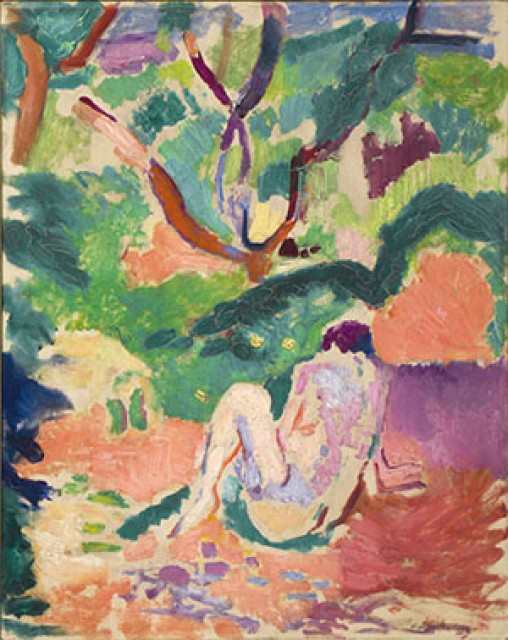Montclair Art Museum
05/24/2017 General

Not far from New York City, nestled among the rolling hills across the wetlands of New Jersey sits the charming township of Montclair. Populated by locals, mixed with New Yorkers who seek a plot of green grass for their offspring to enjoy in the warmer months, Montclair has so much more to offer besides the suburban homestead. There are many wonderful restaurants, beautiful parks designed by Frederick Law Olmsted, the acclaimed Presby Iris Gardens, the Montclair Film Festival, and of course the Montclair Art Museum (MAM).
Founded in 1914, MAM was the first museum in the Garden State completely dedicated to art. The permanent collection emphasizes American art and Native-American art. The museum has one entire gallery devoted to the works of 19th century American painter George Inness, who lived and worked in the area.
Currently on exhibit at MAM are three concurrent shows all thematically relating to the influence of the modern master, Henri Matisse. Matisse was one of the great innovators of the 20th century, working in a wide range of artistic styles, and any exhibition giving viewers a chance to see his works in person is always worth a visit. But what makes these exhibitions special is the intricate curatorial tapestry that the museum’s chief curator, Gail Stavitsky, and her team have woven. Gail has selected works by Matisse and placed them alongside works by American artists influenced by Matisse or by his artistic viewpoint, and those who have incorporated Matisse’s works into their own as an iconic backdrop and part of the fabric of our modern-day lives. These three exhibitions are “Matisse and American Art,” “Inspired by Matisse” and “Janet Taylor Pickett: The Matisse Series.”
“Matisse and American Art” carries us chronologically through the development of modernism beginning with Matisse’s earliest works of 1907. Gail Stavitsky grouped forty-four works by American artists alongside nineteen by Henri Matisse. As I strolled through the exhibit, I realized the depth of the impact of Matisse’s multilayered career on so many artists whose works I know and love. It is quickly apparent while viewing these works how powerful Matisse’s influence is on so much that came after him. The earliest American works on view are those of Max Weber and Sarah Stein, closely followed by Morgan Russell, Alfred Maurer and Arthur Dove. In these works we see the Fauvist palette and flattened picture plane, as well as bold outlines and layered patterning taken from Matisse. These modernists were early visitors to Europe, and were directly influenced. It is important to reflect on the challenges these American artists faced in both the cost and time it took to travel to Paris to witness modernism at its roots. It was also challenging to return to America and work in a modernist idiom where they faced rejection from not just the audience at large but American museums that were championing modernism.
The next generation brings artists like Stuart Davis and Milton Avery. Davis creates a collage-like pattern in his oil compositions that clearly have a dialogue with Matisse’ cut-outs. Avery worked in washes of solid color in rich Fauvist colors that connect more closely to an earlier time in Matisse’ career. Stemming from Avery are the Abstract Expressionists and color field artists such as Hans Hofmann, Robert Motherwell, Mark Rothko and Helen Frankenthaler. Again, Gail Stavitsky successfully connects these artists to the works of Matisse. As the exhibition travels chronologically toward pop artists Roy Lichtenstein and Andy Warhol and up to contemporary art, Stavitsky chose to include works by Warhol and Lichtenstein that make historical reference to Matisse imagery, but interpreted in their own styles. This nod to the master is not unlike the use of a jazz standard in music to introduce a new concept. The show ends with a charming paper collage by Eric Carle. The line between fine art and illustration in the broad scope of visual art is a fuzzy one. Some would casually erase the line, while others guard the separation like a demilitarized zone. But wherever you fall with regard to that argument, most would agree that Carle is a masterful collagist.
“Inspired by Matisse’ is a great expansion to the main gallery. These works are all pulled from the permanent collection of the Montclair Art Museum, and they are in no way lesser works unworthy of the main exhibition. The show consists of 53 works of art by 42 American artists.
In building “Matisse and American Art,” Gail Stavitsky knew early on that she wanted to include a piece by Janet Taylor Picket, the collage “Matisse Blue Dress.” In addition, she included a work by Andy Warhol that also reinterprets Matisse’s “Blue Dress.” Subsequently, she realized that Ms. Picket had made a number of works relating to Matisse, and was making more and more of them throughout the course of her planning the show. I am pleased it was decided to create a separate exhibition for these works. Seen as a group, they complement the other two shows, and are a fascinating study that deserves its own exhibition.
Montclair Art Museum
“Matisse and American Art” is on view through June 18.
“Janet Taylor Pickett: The Matisse Series” is on view through July 2.
“Inspired by Matisse” is on view through July 29.
“Matisse and American Art” received major support from The Henry Luce Foundation, Helen Frankenthaler Foundation, the National Endowment for the Arts, and corporate support from JP Morgan Chase & Co.
MAM is located at 3 South Mountain Avenue in Montclair, New Jersey. For further information, click here.